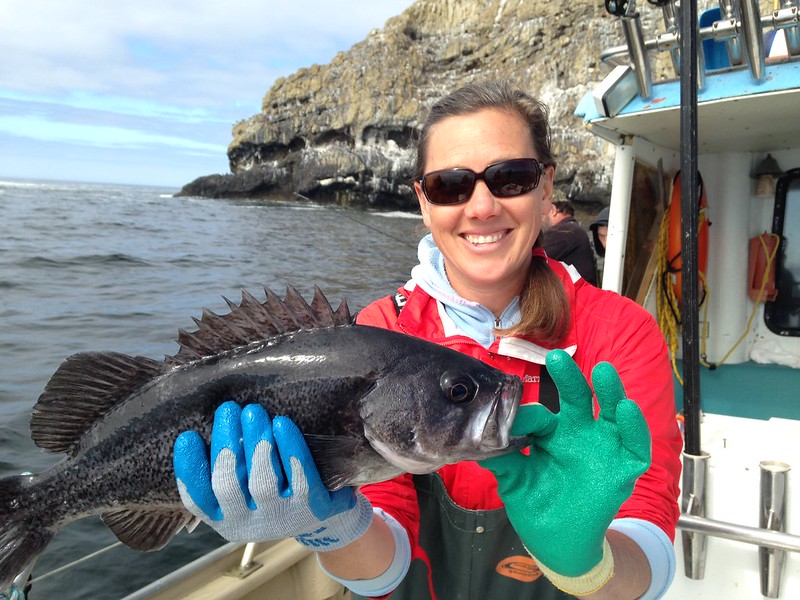By Angela Whitlock, NCLC Marine Reserve Coordinator
Happy eighth anniversary, Cape Falcon Marine Reserve! We are so grateful to receive your abundant gifts and to do what we can to give back in return.
The entire Oregon Marine Reserves Program celebrated a major milestone in 2023, as restrictions went into effect at the first two sites in 2012—and at the others soon after—making for a full 10 years of conservation and scientific research.
But 2024 marks the eight-year anniversary for Cape Falcon Marine Reserve, the youngest (and northernmost) site in Oregon’s Marine Reserves Program. The Oregon Department of Fish & Wildlife (ODFW), which manages the program, started monitoring at Cape Falcon in 2014 and harvest restrictions went into effect Jan. 1, 2016.
To understand the value of Oregon’s Marine Reserves Program, including Cape Falcon, it’s important to consider the current state of our world’s oceans. Unfortunately, they’ve become altered beyond their normal range of variability because of human activities, but marine reserves are proven to help counteract the negative effects.
These designated conservation sites are underwater wilderness areas and living research laboratories. They protect marine habitats and biodiversity, serving as refuges for marine mammals and declining populations of species that are impacted by pollution, coastal development, and overfishing. They contribute to coastal resiliency by helping the ocean and its surrounding communities adapt to issues such as acidification and hypoxia, sea-level rise, and storm intensity.
The Spillover Benefits of Big BOFFFFs
In honor of the Cape Falcon Marine Reserve’s anniversary, we’re celebrating some of the positive outcomes witnessed at the site to date. For instance, when it comes to marine wildlife, reserved areas have demonstrated an increase in biodiversity, species density, and body sizes.
But let’s take a closer look at a specific example: Big Old Fat Fecund (or Fertile) Female Fish, lovingly known to scientists as BOFFFFs (… I like big BOFFFFs, and I cannot lie).
BOFFFFs produce substantially more offspring than smaller fish do, as they’re able to put energy into reproduction as opposed to body growth. Also, the larger the female, the less susceptible they are to predation. Additionally, they have the capacity to spawn for many years, and in a wider range of locations.
They also are more likely to survive unfavorable conditions–and then continue to reproduce when conditions improve. Marine reserves provide a protective habitat for BOFFFFs, where they can live and produce juveniles. And all of this has a significant spillover effect.
Because of their unique characteristics, BOFFFFs are necessary for the sustainability of rockfish species, and they help to sustain fish populations in areas beyond the marine reserve. How cool is that?

such as the one pictured above. Photo: Oregon Marine Reserves Program
Cape Falcon Activities in 2023
Zooming in on this past year at Cape Falcon Marine Reserve, a couple of important research projects took place, many of them ongoing efforts by ODFW and their research partners.
For example, ODFW conducted oceanographic monitoring, deploying sensors at the marine reserve and its comparison area at Cape Meares. Data on ocean temperatures and oxygen levels was collected to help understand hypoxia conditions that affect bottomfish and invertebrate species. Hook-and-line surveys also were conducted this year, and many fish were measured, tagged and released. According to ODFW reports, many of the fish surveyed were Red Irish Lord, and Buffalo Sculpin.
Last but not least, Cape Falcon Marine Reserve’s breathtaking beauty and proximity to Oswald West State Park has provided us with plenty of recreational activities–and will continue to do so in the upcoming year. That includes surfing, hiking, bird watching, beachcombing, tide pooling, and stewardship opportunities for people who love giving back to a natural place they enjoy and benefit from. Our team at NCLC enjoyed getting to host the Tidepool Ambassador Program (TAP), support sea star surveys, lead tide-pooling excursions and hikes, and many other activities at Cape Falcon this past year.
What an exciting eight years it has been so far, and over the next phase of its life, we look forward to continuing our efforts to steward, advocate for, and educate others on the ecological, social, recreational, and inexplicable value of the Cape Falcon Marine Reserve.
Comments
.Good write up enjoyed reading it.
I’ve been concerned lately about our reserve being crab fished at night in the past 3 nights. I have reported this to the State Police and assured the message would be passed on to Fish and Wildlife people who monitor the problem. Maybe you could follow through . Thanks!
Thank you for sharing this information, Joanne. Our Marine Program Coordinator Angela will get in touch with you to follow up!